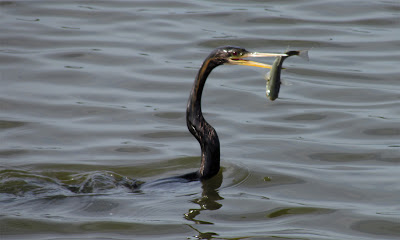One of the most important decisions you can make while birding is which way to go. And I’m not talking about should you take 40 or 95, or the 17 or the Grissom Parkway . More importantly, should you take a right or left at the trailhead? Should you finish the loop or double back? These decisions can alter the very course of a birding adventure. That day, James and I made two different decisions.
I decided to camp out at the Huntington Beach causeway, a legendary place that had tons of birds the day before. I’d hoped that some of the oft-reported Roseate Spoonbills would fly in, but it appears they left several days before we arrived. For the moment, I would have to be content with close looks at a pair of Osprey as they gracefully dove for fish over the shallow pond.
 |
| Honestly he got really close, but he was flying too fast for a good picture. |
James, on the other hand, chose to visit the Atalaya trail, which runs through forests and marshes before terminating at an old homestead. The only problem with this trail is that, as we’d found the day before, there aren’t a whole lot of vantage points for viewing the marsh. And any time you can find a break in the foliage, there are giant Golden Silk Orb Weavers, large spiders that build impressive webs. The whole thing is pretty precarious, but apparently it can work out. James ended up getting great views of this Common Gallinule bathing in the duckweed. It’s a lifer for him, as the Common Moorhens he found in Spain were recently split – I’m still not quite sure why, the two birds look fairly identical to me!
 |
| Just sayin', non-Gallinula species shouldn't be called gallinules... I'm lookin' at you, Porphyrio martinica. |
Next, James decided to visit the feeders by the nature center to get better looks at the multitude of Painted Buntings. Turns out, he didn’t have to go very far – just a short ways down Atalaya, a nice male landed right at his feet! Apparently they do a lot of Painted Bunting banding at Huntington Beach State Park
 |
| How dare he not stop and gaze in wonderment at such a bird? But bro, he totally did a 7:20 mile! |
The boardwalk that runs north of the nature center meanders through the nearby salt marsh. On Saturday, a huge flock of White Ibis lined the sides, but once we showed up to photograph them, a couple of tourists bustled through and flushed them. The same happened to a couple of Green Herons that were chilling on the tall railings. James visited that morning at an hour too early for most people, and one of the Green Herons didn’t mind just one person standing around to take its picture.
 |
| Around here, Green Herons are one of the more skittish birds you can find. But at HBSP, they don't give a damn! |
Back at the causeway, the Wood Storks started streaming in, and some landed much closer than they had on Saturday. Just off the viewing platform, I noticed a school of fish jumping out of the water close by. I wondered if one of the many gators decided to take his chance with smaller prey when I got my answer – not a gator, but a nice Anhinga rose out of the water, with its breakfast impaled on its beak.
 |
| Unbeknownst to most nature enthusiasts, but knownst to us, Anhingas have a hilarious derp-face. |
I’ve never seen Anhingas this close up before, so watching it hunt and feed at point-blank range was all the more exciting. Especially when the bird gets quite animated doing so – to prevent the fish’s dorsal spines from getting stuck in its throat, the Anhinga has to do a juggling act in order to swallow it, tossing the fish in the air until it points the right direction. As if the Anhingas didn’t look like they had a long enough neck already!
 |
| Crazily enough, that crooked neck they have is actually the shape of their neck vertebrae. |
After a hard morning’s fishing, the Anhinga awkwardly waddled up onto a nearby island and turned its back towards the sun, drying its feathers. Unlike most other water-going birds, Anhingas lack oil glands with which to waterproof their feathers, so after swimming, it gets just as wet as you or I. Not that I mind this brief evolutionary shortcoming – it just means that Anhingas get quite photogenic!
 |
| Would you just take the picture already? It's only going to be sitting there for the next hour and a half! |
At this point, a really cool bird flew up next to me, so close I could have touched it. I called James, but he was of course off doing his own thing, and by the time he got there the bird flew back to the water. And then we made the decision to go find a wholly different bird. But these are all stories for another day. Like Friday, perhaps? Check back then for the exciting conclusion of our Huntington Beach adventure!

No comments:
Post a Comment